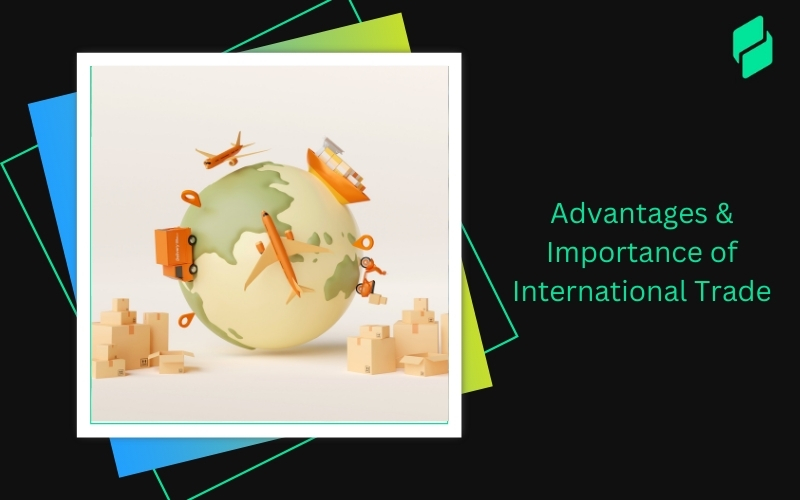Optimize your business: use unlimited savings with Pazago fulfilled now!
Get Started ->Imagine trying to navigate a ship through stormy waters without a map. That's what managing a supply chain without a dashboard feels like.
A Supply Chain Management (SCM) Dashboard serves as your vital map, guiding you through the complex waters of supply chain logistics, from import and export to freight forwarding and beyond.
What is a Supply Chain Management Dashboard?
An SCM Dashboard is a powerful tool designed to provide real-time visibility into every aspect of your supply chain. You can monitor, analyze, and optimize your operations by consolidating data from various sources.
Whether dealing with procurement, logistics, or inventory management, an SCM Dashboard can streamline your processes, reduce costs, and improve efficiency.

Key Features and Functionalities of SCM Dashboards
So, what makes an SCM Dashboard indispensable for your business? Here are some key features:
- Real-Time Data Tracking: Monitor your supply chain activities as they happen. From tracking shipments to managing inventory levels, real-time data keeps you informed and ready to act.
- Customizable Metrics: Tailor your dashboard to display the metrics that matter most to your business. This will give you a personalized view of your operations, whether delivery times, freight costs, or supplier performance.
- Predictive Analytics: Use historical data to forecast future trends. This helps in planning for demand, reducing lead times, and minimizing stockouts or overstock situations.
- Integration Capabilities: Seamlessly integrate with other systems such as ERP, CRM, and WMS. This ensures all your data is synchronized and accessible from one central location.
- Interactive Visualizations: Utilize graphs, charts, and maps to visualize your data. This makes it easier to identify patterns, trends, and areas for improvement.
Navigate Your Trade with Confidence!
Leverage Pazago's Portal to manage your trades, create documents, and track shipments 24/7. Start making smarter, data-driven decisions today!
Also Read: Understanding the Importance and Strategies of Retail Supply Chain Management
Types of SCM Dashboards
Not all dashboards are created equal. Depending on your needs, you might find one type more beneficial. Here are the three main types of SCM Dashboards:
1. Operational Dashboards
Operational dashboards are all about the here and now. They provide real-time insights into your daily operations, helping you manage tasks such as order processing, shipment tracking, and inventory control.
If you want to improve day-to-day efficiency and responsiveness, an operational dashboard is your go-to tool.

2. Tactical Dashboards
Tactical dashboards focus on mid-term performance. They help you monitor and manage projects, track progress against KPIs, and execute your strategies effectively.
Use a tactical dashboard to make informed decisions about resource allocation, process improvements, and supplier negotiations.

3. Strategic Dashboards
Strategic dashboards are designed for long-term planning and decision-making. They provide a high-level overview of your supply chain performance, highlighting trends, opportunities, and risks.
This type of dashboard is essential for executives and senior managers who need to align supply chain activities with business goals and market dynamics.

Choose Your Path to Success!
Whether you need operational, tactical, or strategic insights, Pazago has the right solution to optimize your business scale. Connect with us to see your business's pace and style.
Also Read: Understanding Different Types of Logistics in Supply Chain Management
Benefits of SCM Dashboards
Let’s dive into the key benefits of implementing an SCM Dashboard in your operations.

1. Improved Visibility and Transparency
Ever felt like you’re operating in the dark? With an SCM Dashboard, those days are over. You get complete visibility into every part of your supply chain.
Real-time data allows you to track shipments, monitor inventory, and oversee supplier performance. This transparency helps you identify bottlenecks and inefficiencies quickly, ensuring smoother operations.
2. Enhanced Decision-Making Capabilities
Are you making decisions based on guesswork? An SCM Dashboard provides the data you need to make informed decisions. By analyzing trends and patterns, you can anticipate issues before they arise.
Whether adjusting procurement schedules or optimizing transportation routes, you have the insights to make proactive choices that benefit your business.
3. Real-Time Data and Analytics
In today’s fast-paced world, outdated information is useless. An SCM Dashboard offers real-time data and analytics, ensuring you’re always working with the latest information.
This immediate access to data helps you respond swiftly to changes in demand, supply chain disruptions, or unexpected events, keeping your operations agile and resilient.
4. Increased Efficiency and Productivity
Imagine cutting down the time spent on manual data entry and reporting. An SCM Dashboard automates these processes, allowing your team to focus on more strategic tasks.
Streamlining workflows and eliminating redundant activities boost efficiency and productivity across your supply chain. This means faster turnaround times and better service for your customers.
5. Cost Reduction and Risk Management
Who doesn’t want to save money and reduce risks? An SCM Dashboard helps you achieve both. By providing insights into cost drivers and potential risks, you can implement strategies to reduce expenses and mitigate risks.
For example, identifying inefficiencies in your logistics operations can lead to significant cost savings, while proactive risk management helps avoid costly disruptions.
Enhance Your Decision-Making with Pazago!
Gain unmatched transparency and improve your response times with our real-time data tracking and analysis. Experience the Pazago difference today!
Also Read: Understanding the Benefits and Advantages of Logistics Management
Key Metrics and KPIs in Supply Chain Dashboards
Let’s explore the essential metrics you should track to optimize your supply chain.
Optimize your inventory levels and order fulfillment rates with Pazago's precise tracking features. Let's set your benchmarks for success together.
Also Read: Understanding What Are The Elements Of Logistics System?
Implementing a SCM Dashboard
Implementing an SCM Dashboard can seem daunting, but it can be a smooth and rewarding process with the right approach.
Let’s break down the steps to get you started, integrate your data, customize your dashboard, and ensure your team is fully trained and supported.

Steps to Get Started
Implementing an SCM Dashboard involves several key steps. Here’s how you can get started:
- Identify Your Goals: What do you want to achieve with your SCM Dashboard? Define clear objectives, improve visibility, enhance decision-making, or optimize logistics.
- Choose the Right Dashboard Solution: Research and select an SCM Dashboard solution that fits your needs. Consider scalability, ease of use, integration capabilities, and cost.
- Plan Your Implementation: Develop a detailed implementation plan. Outline the steps, timeline, and resources needed. Assign roles and responsibilities to ensure everyone knows their part.
- Start Small: Begin with a pilot project. Implement the dashboard in one part of your supply chain to test its effectiveness and identify any issues before a full-scale rollout.
Data Integration and Sources
Data is the backbone of an SCM Dashboard. Here’s how to ensure seamless data integration:
- Identify Data Sources: Determine all the data sources you’ll need, such as ERP systems, CRM software, warehouse management systems, and transportation management systems.
- Ensure Data Accuracy: Clean and standardize your data to ensure accuracy. Inaccurate data can lead to poor decision-making and inefficiencies.
- Automate Data Collection: Set up automated processes to collect and update data in real time. This reduces manual effort and ensures your dashboard always displays the latest information.
- Integrate Systems: Use integration tools and APIs to connect your data sources with your SCM Dashboard. This creates a unified view of your supply chain operations.
Customization and User Roles
Every business is unique, and so are its dashboard needs. Customization is key:
- Tailor the Dashboard: Customize the dashboard to display the metrics and KPIs that matter most to your business. Create different views for user roles to ensure everyone can access relevant information.
- Define User Roles: Assign roles and permissions based on job functions. For example, procurement teams might need access to supplier performance data, while logistics teams focus on transportation metrics.
- Create Alerts and Notifications: Set up alerts for critical events like low inventory levels or delayed shipments. This ensures prompt action and keeps everyone informed.
Training and Support
A powerful tool is only as good as the people who use it. Here’s how to ensure your team is ready:
- Provide Comprehensive Training: Offer training sessions to help users understand how to use the dashboard effectively. This includes navigating the interface, interpreting data, and generating reports.
- Develop User Guides: Create user manuals and guides that provide step-by-step instructions. These serve as valuable resources for new users and help troubleshoot common issues.
- Offer Ongoing Support: Establish a support system to assist users with questions or technical issues. This could include a helpdesk, online resources, and regular check-ins.
- Encourage Feedback: Collect feedback from users to identify areas for improvement. Use this feedback to make necessary adjustments and enhancements to the dashboard.
Implement with Ease, Scale with Peace!
Start with Pazago's to scale your trade operations without hassle. Let us guide you through every step of your journey.
Also Read: What Are E Supply Chain Management?
Challenges and Solutions in Implementing SCM Dashboards
Let’s explore the common challenges you might face and the best practices to overcome them, ensuring a smooth and successful implementation.
Overcome Obstacles with Pazago!
Tackle common implementation challenges using our robust support and customized solutions. Join hands with Pazago for a smoother trade management experience.
Also Read: Logistics Park: The Core of Logistics Operations
Future Trends in SCM Dashboards
Imagine having a supply chain that anticipates problems before they occur, adapts to real-time changes, and operates sustainably. This is the future of SCM Dashboards, driven by cutting-edge technologies and innovative practices.

Let’s explore the exciting trends shaping the future of supply chain management dashboards.
1. Predictive Analytics and AI
Ever wished you could see into the future? With predictive analytics and AI, your SCM Dashboard can come pretty close. These technologies analyze historical data to predict future trends, helping you make proactive decisions.
For instance, AI can forecast demand, identify potential disruptions, and suggest optimal inventory levels. This means fewer surprises and more efficient operations.
2. IoT Integration
Imagine knowing the exact location and condition of your shipments at any moment. The Internet of Things (IoT) makes this possible. You can track assets in real-time by integrating IoT devices with your SCM Dashboard.
Sensors can monitor temperature, humidity, and other conditions, ensuring the integrity of sensitive goods. This level of visibility helps maintain quality and reduce losses.
3. Blockchain Technology
Worried about transparency and trust in your supply chain? Blockchain technology can revolutionize how you track and verify transactions.
By providing a secure and immutable record of every transaction, blockchain ensures transparency and reduces the risk of fraud. This means more reliable documentation and easier compliance with regulations for import and export.
4. Sustainability and Green Supply Chains
Are you looking to make your supply chain more environmentally friendly? The future of SCM Dashboards includes a strong focus on sustainability.
Dashboards can now track carbon footprints, optimize routes to reduce fuel consumption, and monitor compliance with environmental regulations. Embracing green supply chains helps the planet, enhances your brand’s reputation, and reduces costs.
Future-Proof Your Business Today!
Embrace innovative technologies, Pazago, and ensure your trade operations are sustainable and ahead of the curve. Explore what's next in your industry with us.
Also Read: Emerging trends in logistics and their meaning
Conclusion
Don’t let your supply chain run on guesswork. Invest in an SCM Dashboard to gain the visibility and control needed to drive your business forward.
Start by identifying your goals and choosing a solution that fits your needs. Involve your team early, ensure seamless data integration, and provide comprehensive training.
Ready to take the leap?
Elevate your supply chain management to world-class standards. Contact Pazago today and enter a new era of optimized and controlled trade operations.
Don’t Guess—Know with Pazago!


.png)








